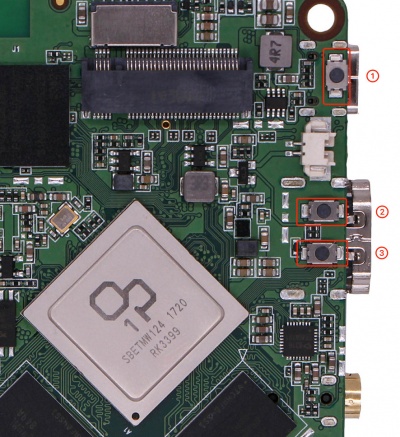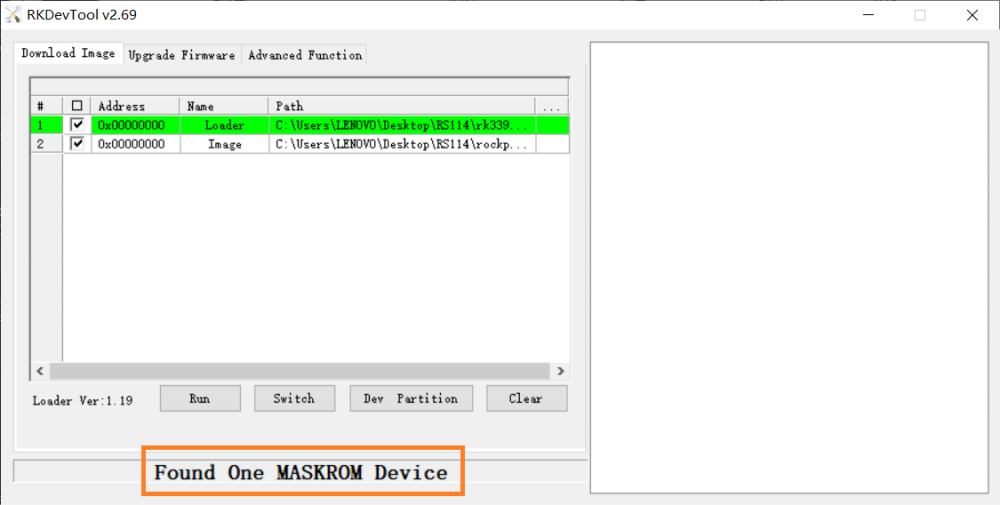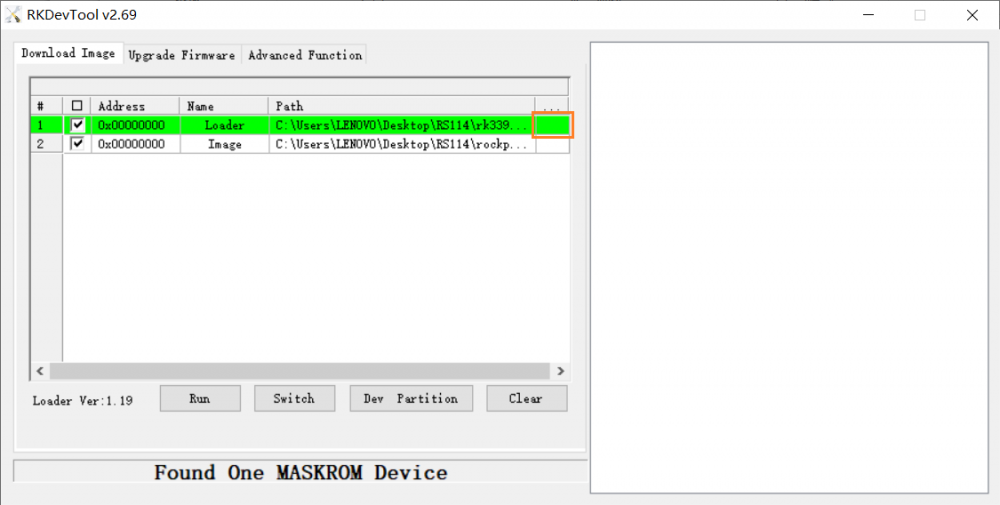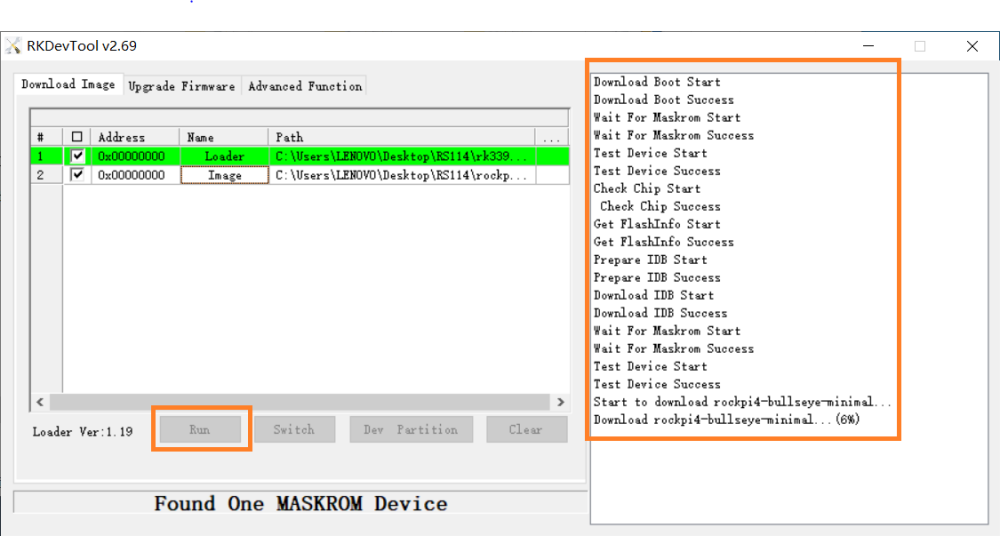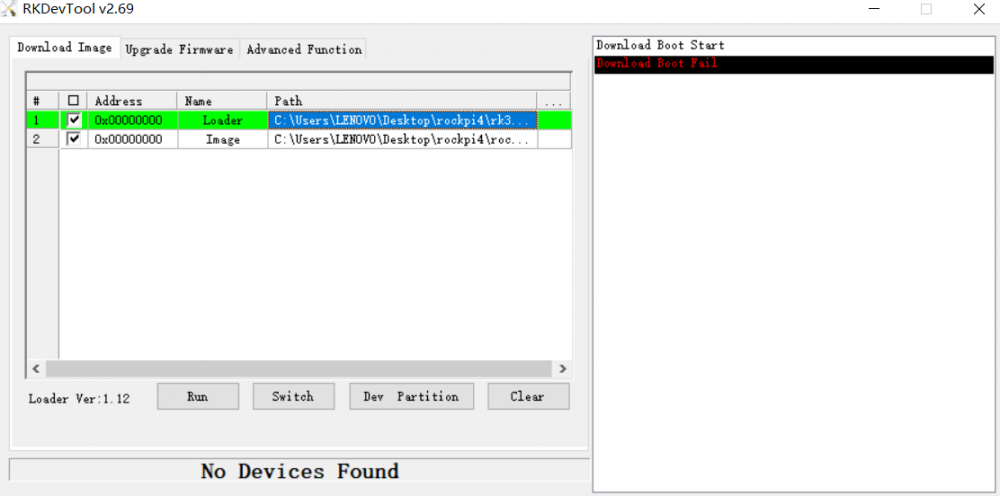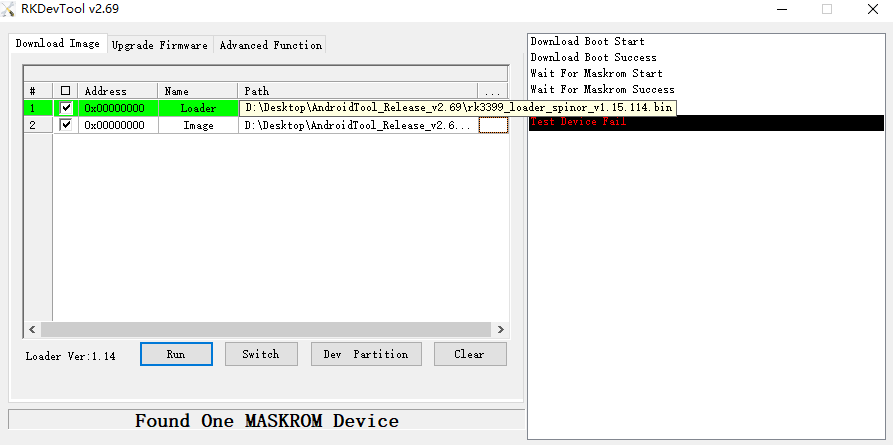Difference between revisions of "Rockpi4/dev/usb-install"
m (Fixed labels on buttons according to here: https://forum.radxa.com/t/rock-pi-4b-unable-to-enter-maskrom/6725) |
|||
| Line 1: | Line 1: | ||
{{rockpi4_header}} | {{rockpi4_header}} | ||
{{Languages|rockpi4/dev/usb-install}} | {{Languages|rockpi4/dev/usb-install}} | ||
| − | [[rockpi4 | ROCK Pi 4]] > [[rockpi4/dev | Development]] > [[rockpi4/dev/usb-install | Install from USB OTG port]] | + | [[rockpi4 | ROCK Pi 4]] > [[rockpi4/dev | Development]] > [[rockpi4/dev/usb-install | Install image to eMMC from USB OTG port]] |
| − | + | == Install image to eMMC from USB OTG port == | |
| − | The PC | + | ROCK Pi 4 supports Maskrom mode, which is a special operation mode for CPU to wait for USB OTG port command. |
| − | We use | + | The Linux/macOS PC tool we use to communicate with ROCK Pi 4 in Maskrom mode are the '''rkdeveloptool''' and '''RKDevTool'''. |
| + | We use tool rkdeveloptool in Linux/macOS and RKDevTool tool under Windows. | ||
=== Requirement === | === Requirement === | ||
* ROCK Pi 4 mainboard | * ROCK Pi 4 mainboard | ||
| − | * eMMC module | + | * eMMC module or eMMC on board |
* Power adapter | * Power adapter | ||
* '''USB Male A to Male A cable'''(important) USB C to USB A cable does not working on all PCs. [https://forum.radxa.com/t/otg-flashing-not-working/717 See discussion]. | * '''USB Male A to Male A cable'''(important) USB C to USB A cable does not working on all PCs. [https://forum.radxa.com/t/otg-flashing-not-working/717 See discussion]. | ||
=== Install Tools&Drivers === | === Install Tools&Drivers === | ||
| + | Please check this guide, [[rockpi4/install/rockchip-flash-tools | Install rockchip flash tools, rkdeveloptool/RKDevTool, under Windows/Linux/MacOS PC]]. | ||
| − | |||
| − | |||
| − | |||
| − | |||
| − | |||
| − | |||
| − | |||
| − | |||
| − | |||
| − | |||
| − | |||
| − | |||
| − | |||
| − | |||
| − | |||
| − | |||
| − | |||
| − | |||
| − | |||
| − | |||
| − | |||
| − | |||
| − | |||
| − | |||
| − | |||
| − | |||
| − | |||
| − | |||
| − | |||
| − | |||
| − | |||
| − | |||
| − | |||
| − | |||
| − | |||
| − | |||
| − | |||
| − | |||
| − | |||
| − | |||
| − | |||
| − | |||
| − | |||
| − | |||
| − | |||
| − | |||
| − | |||
| − | |||
| − | |||
| − | |||
| − | |||
| − | |||
| − | |||
| − | |||
| − | |||
| − | |||
| − | |||
| − | |||
| − | |||
| − | |||
| − | |||
| − | |||
| − | |||
| − | |||
| − | |||
| − | |||
| − | |||
| − | |||
| − | |||
| − | |||
| − | |||
| − | |||
| − | |||
| − | |||
| − | |||
| − | |||
| − | |||
| − | |||
| − | |||
| − | |||
| − | |||
| − | |||
| − | |||
| − | |||
| − | |||
| − | |||
| − | |||
| − | |||
| − | |||
| − | |||
| − | |||
| − | |||
| − | |||
=== Boot the board to maskrom mode === | === Boot the board to maskrom mode === | ||
| − | To boot ROCK Pi into maskrom mode is simple: | + | To boot ROCK Pi 4 into maskrom mode is simple: |
* 1. Power off the board | * 1. Power off the board | ||
| − | ** | + | ** Remove microSD card |
| − | ** | + | ** Remove eMMC module If your board has one removable eMMC module |
| − | ** if your board is Plus version with soldered eMMC | + | ** Press and hold the Maskrom key if your board is Plus version with soldered eMMC (1: Reset 2: Maskrom 3: Recovery) |
[[File:Rockpi4bplus_key.jpg|400px]] | [[File:Rockpi4bplus_key.jpg|400px]] | ||
* 2. Plug the USB Male A to Mail A cable to ROCK Pi 4 OTG port(the upper USB3 port), the other side to PC | * 2. Plug the USB Male A to Mail A cable to ROCK Pi 4 OTG port(the upper USB3 port), the other side to PC | ||
| − | * 3. Power on the board | + | * 3. Power on the board and release the maskrom key(important) |
| − | + | * 4. Confirm that ROCK Pi 4 is in Maskrom mode . | |
| + | ** For macOS host: lsusb result: '''Bus 000 Device 004: ID 2207:330c Fuzhou Rockchip Electronics Co., Ltd. Composite Device''' | ||
| + | ** For Linux host: lsusb result: '''Bus 001 Device 112: ID 2207:330c Fuzhou Rockchip Electronics Company''' | ||
| + | ** For Windows host: Open RKDevTool and you would see the device is in '''Found One MASKROM Device'''. | ||
| + | [[File:AndroidTool1.PNG | 1000px]] | ||
| − | + | * 5. Now plug the eMMC module and proceed the next step to flash. (Only for removable eMMC module) | |
| − | + | ||
| − | + | ||
| − | + | ||
| − | + | ||
| − | + | ||
| − | + | ||
| − | + | ||
| − | + | ||
| − | + | ||
| − | + | ||
| − | + | ||
| − | * 5. Now plug the eMMC module and proceed the next step to flash. | + | |
Alternatively, if you are running Android and can access ADB, you can reboot the device to loader mode `adb reboot bootloader` then use the rkdeveloptool to reset the device into maskrom mode `rkdeveloptool rd 3` or Windows AndroidTool '''Switch''' button to go to maskrom mode. | Alternatively, if you are running Android and can access ADB, you can reboot the device to loader mode `adb reboot bootloader` then use the rkdeveloptool to reset the device into maskrom mode `rkdeveloptool rd 3` or Windows AndroidTool '''Switch''' button to go to maskrom mode. | ||
| Line 176: | Line 77: | ||
<div class="mw-collapsible-content"> | <div class="mw-collapsible-content"> | ||
| − | Double click the ''' | + | Double click the '''RKDevTool.exe''' and you will see the following interface: |
| − | If your ROCK Pi is in maskrom mode and connects to PC, you can see that the program detect it, as the red box shown below: | + | If your ROCK Pi 4 is in maskrom mode and connects to PC, you can see that the program detect it, as the red box shown below: |
| − | [[File:AndroidTool1.PNG | | + | [[File:AndroidTool1.PNG | 1000px]] |
===== Step 1: Select Loader ===== | ===== Step 1: Select Loader ===== | ||
| Line 185: | Line 86: | ||
Next, click the button in the red box on the right last columns select the loader "rk3399_ loader_ xxxxx.bin ", | Next, click the button in the red box on the right last columns select the loader "rk3399_ loader_ xxxxx.bin ", | ||
| − | [[File:AndroidTool8.PNG | | + | [[File:AndroidTool8.PNG | 1000px]] |
''Note:'' the loader (flash helper) is used to init the ram and prepare the flashing environment etc. If you don't have it, you can download it from [https://dl.radxa.com/rockpi/images/loader/ here] | ''Note:'' the loader (flash helper) is used to init the ram and prepare the flashing environment etc. If you don't have it, you can download it from [https://dl.radxa.com/rockpi/images/loader/ here] | ||
| Line 194: | Line 95: | ||
''Note'': Normally the image name should ends with xxx-gpt.img. If the image name ends with xxx-rkupdate.img, you can not flash with this method. | ''Note'': Normally the image name should ends with xxx-gpt.img. If the image name ends with xxx-rkupdate.img, you can not flash with this method. | ||
| − | |||
===== Step 3: Run ===== | ===== Step 3: Run ===== | ||
| Line 200: | Line 100: | ||
Finally, click the "run" button in the red box below, and you will see the content in the red box on the right. When the progress reaches 100%, the download is completed. | Finally, click the "run" button in the red box below, and you will see the content in the red box on the right. When the progress reaches 100%, the download is completed. | ||
| − | [[File:Androidtool5.PNG | | + | [[File:Androidtool5.PNG | 1000px]] |
</div> | </div> | ||
</div> | </div> | ||
| Line 241: | Line 141: | ||
If you meet such these situations, you can try to change the bin file by [https://dl.radxa.com/rockpi/images/loader/ rk3399_loader_v1.20.119.bin] | If you meet such these situations, you can try to change the bin file by [https://dl.radxa.com/rockpi/images/loader/ rk3399_loader_v1.20.119.bin] | ||
| − | [[File:error-loader1.png | | + | [[File:error-loader1.png | 1000px]] |
| − | [[File:error-loader2.png | | + | [[File:error-loader2.png | 1000px]] |
=== Troubleshooting === | === Troubleshooting === | ||
* If you have issue with flashing via USB OTG, start a new post on the forum. https://forum.radxa.com/c/dev | * If you have issue with flashing via USB OTG, start a new post on the forum. https://forum.radxa.com/c/dev | ||
Revision as of 01:58, 9 January 2022
ROCK Pi 4 > Development > Install image to eMMC from USB OTG port
Contents
Install image to eMMC from USB OTG port
ROCK Pi 4 supports Maskrom mode, which is a special operation mode for CPU to wait for USB OTG port command. The Linux/macOS PC tool we use to communicate with ROCK Pi 4 in Maskrom mode are the rkdeveloptool and RKDevTool. We use tool rkdeveloptool in Linux/macOS and RKDevTool tool under Windows.
Requirement
- ROCK Pi 4 mainboard
- eMMC module or eMMC on board
- Power adapter
- USB Male A to Male A cable(important) USB C to USB A cable does not working on all PCs. See discussion.
Install Tools&Drivers
Please check this guide, Install rockchip flash tools, rkdeveloptool/RKDevTool, under Windows/Linux/MacOS PC.
Boot the board to maskrom mode
To boot ROCK Pi 4 into maskrom mode is simple:
- 1. Power off the board
- Remove microSD card
- Remove eMMC module If your board has one removable eMMC module
- Press and hold the Maskrom key if your board is Plus version with soldered eMMC (1: Reset 2: Maskrom 3: Recovery)
- 2. Plug the USB Male A to Mail A cable to ROCK Pi 4 OTG port(the upper USB3 port), the other side to PC
- 3. Power on the board and release the maskrom key(important)
- 4. Confirm that ROCK Pi 4 is in Maskrom mode .
- For macOS host: lsusb result: Bus 000 Device 004: ID 2207:330c Fuzhou Rockchip Electronics Co., Ltd. Composite Device
- For Linux host: lsusb result: Bus 001 Device 112: ID 2207:330c Fuzhou Rockchip Electronics Company
- For Windows host: Open RKDevTool and you would see the device is in Found One MASKROM Device.
- 5. Now plug the eMMC module and proceed the next step to flash. (Only for removable eMMC module)
Alternatively, if you are running Android and can access ADB, you can reboot the device to loader mode `adb reboot bootloader` then use the rkdeveloptool to reset the device into maskrom mode `rkdeveloptool rd 3` or Windows AndroidTool Switch button to go to maskrom mode.
Begin Installation USB -> eMMC
Linux/macOS
On your PC, run the rkdeveloptool
rkdeveloptool ld # List the device DevNo=1 Vid=0x2207,Pid=0x330c,LocationID=305 Maskrom
Download the loader (flash helper) to init the ram and prepare the flashing environment etc. If you don't have it, you can download it from here
rkdeveloptool db rk3399_loader_vxxxx.bin
Write the GPT image to eMMC, start to write from offset 0.
rkdeveloptool wl 0 /path/to/rockpi4b-xxx-gpt.img
Reboot the device
rkdeveloptool rd
Now the device should boot the new image on eMMC
Please notice that when you want to erase eMMC on board, you can use this command. Get zero.img from here.
rkdeveloptool db rk3399_loader_vxxxx.bin rkdeveloptool wl 0 zero.img
Windows
Double click the RKDevTool.exe and you will see the following interface: If your ROCK Pi 4 is in maskrom mode and connects to PC, you can see that the program detect it, as the red box shown below:
Step 1: Select Loader
Next, click the button in the red box on the right last columns select the loader "rk3399_ loader_ xxxxx.bin ",
Note: the loader (flash helper) is used to init the ram and prepare the flashing environment etc. If you don't have it, you can download it from here
Step 2: Select Image
Then click the right last columns to in the Image row and choose the image you want to flash.
Note: Normally the image name should ends with xxx-gpt.img. If the image name ends with xxx-rkupdate.img, you can not flash with this method.
Step 3: Run
Finally, click the "run" button in the red box below, and you will see the content in the red box on the right. When the progress reaches 100%, the download is completed.
Install by partitions(Advanced)
Linux/macOS
Sometimes we only want to update a partition of the image, for example only the boot partition to update kernel only. We can flash by partitions
| Part Number | Offset | Name | Description | | ----------- | ------ | ------- | -------------------------- | | 1 | 32KB | loader1 | First stage loader | | 2 | 8MB | loader2 | U-boot image | | 3 | 12MB | trust | ATF | | 4 | 16MB | boot | Kernel partition, bootable | | 5 | 128MB | rootfs | Rootfs |
When the board is in maskrom mode, flash the partitions with the following command and offset:
rkdeveloptool db rk3399_loader_*.bin rkdeveloptool wl 64 idbloader.img rkdeveloptool wl 16384 uboot.img rkdeveloptool wl 24576 trust.img rkdeveloptool wl 32768 boot.img rkdeveloptool wl 262144 rootfs.img
Windows
TBD.
FAQ
If you meet such these situations, you can try to change the bin file by rk3399_loader_v1.20.119.bin
Troubleshooting
- If you have issue with flashing via USB OTG, start a new post on the forum. https://forum.radxa.com/c/dev

